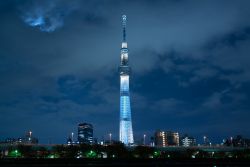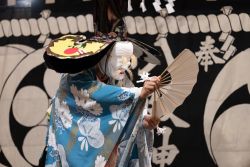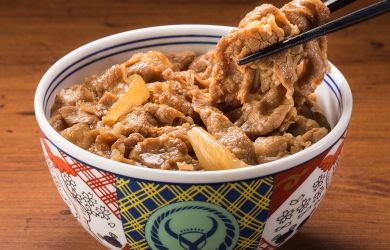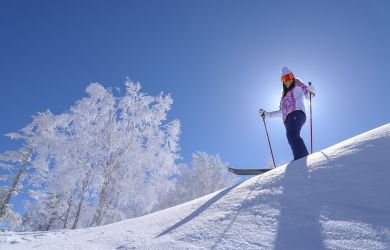
July 28, 2005
Big sky country
Endless vistas and mysterious shrines await in rural Mongolia
By Metropolis
Originally published on metropolis.co.jp on July 2005

After bashing across the Mongolian steppe for an hour in a Korean van that seemed to be equipped with square wheels and granite tires, there was still no sign of our destination, a shamanic shrine called the Eej Khad, or “Mother Rock.” The guidebooks had led me to believe it was a quick hop outside the capital, Ulan Bator.
I’m not sure exactly what a Mother Rock looks like, but I don’t see anything that might remotely resemble one in this 360-degree panorama of rolling grasslands and lapis lazuli skies punctuated with dramatic clouds.
The rock is said to grant wishes to those who have a sincere belief in its powers and is venerated by many Mongolians. The Lonely Planet says that when the communists were in power in the ’70s, they tried to dynamite the rock, but their attempts were all mysteriously foiled.
The grass is still low in June and mixed with straw-colored stubble. Still, the wide-open vistas are gorgeous and brushed with a hint of melancholy. Mongolia is one of the most sparsely populated countries on Earth, and in an hour of off-road driving we’ve only seen one ger, the round canvas-covered tent that shelters most rural dwellers and a good portion of urbanites as well.
From the van we occasionally see men mounted on small, tough horses herding sheep, goats and cattle. The fluid grace and confidence the Mongols exhibit as they ride over the rough plain is always a sight to behold. There are no fences anywhere, and it doesn’t take much effort to imagine we’re in the American West a few hundred years ago.
After another hour and a half of hard travel, we crest a hill and the landscape takes on a barren, lunar aspect. In the middle of this moonscape sits a small, weathered, ger-shaped building with a tin roof. This unimpressive edifice is home to the Mother Rock.

Tymee, the driver, parks the van. We grab milk, candies, incense, bricks of tea and blue silk scarves called khatags, which we’ve brought to offer the lady rock. Then we head for the shrine.
Somber worshippers are lined up outside the building. Inside, it’s redolent of Tibetan juniper incense, vodka and an ancient accumulation of fermented milk. The sacred rock appears to be granite and is about 2 meters high and nearly as wide. It’s almost completely covered in a colorful khatags. Men worship on one side and women on the other.
Tymee guides me through the offering ritual, and soon it’s my turn to grasp the rock and pray that she will grant me two secret wishes. Afterward we circle the building three times, sprinkling milk on it and the ground as we go. In a few minutes we are back in the van and headed to a nearby ger for an al fresco feast of mutton before heading back to Ulan Bator.
After the shamanic ritual, sitting on the open plain gnawing on hunks of mutton on the bone makes me feel as though I had slipped back in time a few thousand years.
Travel in Mongolia can be taxing, but anyone who has been there will tell you the rewards are great. The tourist season runs roughly from mid-June through mid-September. Winter can be bitter cold with temperatures reaching -40º Celsius. But hardy souls who dress warm will find the dry cold is easy to tolerate.
Last November, I visited Kharkhorin, the site of the ancient Mongol capitol and its first Buddhist monastery, Erdene Zuu. It’s about an eight-hour drive from Ulan Bator over a paved but potholed highway. At one Old West-style truck stop, we found traditionally dressed Mongolians huddled around a television watching their compatriot Asashoryu manhandle another opponent out of the sumo ring.
In Kharkhorin we stayed in a ger owned by a curator at nearby Erdene Zuu, which is both a museum and a functioning Buddhist temple. Its most memorable feature is a whitewashed wall with 108 stupas that surrounds the complex.
After a day of sightseeing at the temple center, we spent the night sampling the local beer and vodka in our ger with a musician who performed the amazing Mongolian throat singing known as khoomei. A khoomei singer produces a gravelly low note and overlays a melody with a high pitched vibrating sound. The effect is otherworldly.
Ulan Bator is another destination that can be visited year round, and if you’re a history or Buddhist-art buff, you’ll need to budget a few days to take in the museums and temples. Particularly nice is the Zanabazar Museum, which houses masterfully cast bronze sculptures created by the revered Mongolian Buddhist sculptor Zanabazar in the 17th century.
Whether you take decide on an expedition deep into the countryside or just laze around Ulan Bator, about as much adventure and mutton as you can handle awaits you in Mongolia. Don’t forget to pack your patience and plenty of dental floss.
Miat Mongolian Airlines (www.miat.com) has direct flights (4 hours) from Narita to Ulan Bator three times a week in summer and twice a week in winter. Summer is the easiest time to visit, but even then temperatures can range from 0ºC to 30ºC. Don’t be afraid to visit in winter—it’s lovely, just be sure to dress for temperatures down to -40Cº. If you want a guided experience, Mongol Reisen tours come highly recommended. For more info, contact Mr. Yura Enkhtuvshin at enkhtuvshin.y@mongoliajourneys.com Mongolian visa info can be obtained from the Mongolian Embassy in Tokyo: Shoto Pinecrest Mansion, 21-4 Kamiyama-cho, Shibuya-ku. Tel: 03-3469-2088.
[geo_mashup_map]





